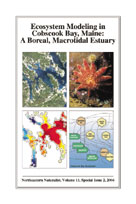Late 20th-Century changes in the intertidal distributions of macroinvertebrates within five sample sites in the Cobscook Bay, ME, region were evaluated by comparisons with qualitative baselines, some as old as 35 years. These baselines were generated by the Maine State Planning Office Critical Areas Program (1970–1987), which recognized the unique distributions of macroinvertebrates and high diversity of intertidal communities in Cobscook Bay that had attracted many zoologists dating back to the early 1800s. The sample sites were critical invertebrate areas registered by the Critical Areas Program between 1968 and 1976. None of the sample sites had been re-examined for at least 20 years, and all but one had been evaluated at least twice previous to this study. Many species, including those whose presence was used to designate habitats as critical, were common or abundant in original site descriptions, but rare or absent in 2002. The dramatic change in community composition away from species typical of hard bottoms to established mussel beds suggests a faunal shift has occurred. The principal driving force that produced this change is proposed to be disturbance from increased sedimentation that altered intertidal habitats. Potential sources of this disturbance and possible cascades that followed are discussed.
How to translate text using browser tools
1 December 2004
Late 20th-Century Qualitative Intertidal Faunal Changes in Cobscook Bay, Maine
Thomas J. Trott
ACCESS THE FULL ARTICLE

Northeastern Naturalist
Vol. 11 • No. sp2
December 2004
Vol. 11 • No. sp2
December 2004




